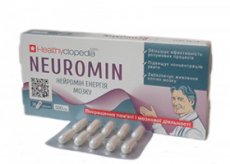Medical expert of the article
New publications
Preparations
Neuromin
Last reviewed: 04.07.2025

All iLive content is medically reviewed or fact checked to ensure as much factual accuracy as possible.
We have strict sourcing guidelines and only link to reputable media sites, academic research institutions and, whenever possible, medically peer reviewed studies. Note that the numbers in parentheses ([1], [2], etc.) are clickable links to these studies.
If you feel that any of our content is inaccurate, out-of-date, or otherwise questionable, please select it and press Ctrl + Enter.

Neuromin is an antianemic substance containing cyanocobalamin.
Indications Neuromina
It is used for various types of anemia: posthemorrhagic, malignant, iron deficiency, aplastic (in children), alimentary, and also caused by toxic components and medications; also for other types of anemia that occur due to a lack of cyanocobalamin, regardless of what caused this deficiency (gastric resection, worms, pregnancy or intestinal absorption disorder).
It is used for radiculitis, polyneuritis, trigeminal neuralgia, migraines and causalgia, as well as for Down syndrome, cerebral palsy, diabetic neuritis, alcoholic delirium and Charcot's disease.
It is prescribed for sprue (in combination with vitamin B9), psoriasis, neurodermatitis, liver pathologies (cirrhosis or hepatitis), photodermatoses, and also for the herpetiform variety of dermatitis and radiation sickness.
Release form
The component is released in injection liquid, inside 1 ml ampoules. The box contains 5 such ampoules.
Pharmacodynamics
Methylcobalamin helps activate protein, lipid and carbohydrate metabolism, is a participant in the binding of labile categories, as well as the formation of methionine with creatine and choline with nucleic acids. Along with this, it helps the accumulation of bonds with sulfhydryl categories inside erythrocytes. Being a growth factor, it activates bone marrow activity, necessary for the normoplastic form of erythropoiesis.
Methylcobalamin helps to stabilize the impaired functioning of the nervous system and liver, activates blood clotting processes and (in large doses) leads to an increase in thromboplastic and prothrombin activity.
In the human and animal organism it is bound in the intestinal microflora, although this does not provide the need for obtaining the vitamin completely. Therefore, an additional part of this element is obtained with food.
 [ 7 ]
[ 7 ]
Pharmacokinetics
The level of protein synthesis is 90%. The time to reach Cmax values with intramuscular and subcutaneous administration is 60 minutes.
Excretion occurs with bile and through the kidneys. The substance can cross the placenta.
 [ 8 ]
[ 8 ]
Dosing and administration
The medication should be administered intravenously, subcutaneously or intramuscularly, and also intralumbarly.
In case of anemia associated with cyanocobalamin deficiency, adults should take 0.1-0.2 mg of the substance every other day until remission is achieved.
In case of development of signs of funicular myelosis, as well as in case of macrocytic anemia accompanied by damage to the nervous system, the medicine is prescribed to an adult in a 1-fold dosage of 0.4-0.5 mg and higher. During the 1st week it is used daily, and then at 5-7-day intervals (B9-vitamin is used together with the medicine). In severe stages of the disease it should be administered into the spinal canal, first in a 1-time portion of 15-30 mcg; with each new administration the portion should be increased (50, 100, and then 150 and 200 mcg). Intralumbar injections should be carried out with 3-day breaks, and the whole cycle includes 8-10 injections. During remission, if there are no signs of the disease, 0.1 mg is administered 2 times a month as a maintenance treatment; if neurological manifestations are present, administer 0.2-0.4 mg 2-4 times a month.
In case of iron deficiency or posthemorrhagic anemia, 30-100 mcg of the drug is used 2-3 times a week. In case of aplastic type of the disease in a child, 0.1 mg of the drug is used until clinical and hematological improvement is registered. In case of alimentary form of pathology (in infants) and anemia in a premature baby, it is necessary to use 30 mcg of the drug per day for 15 days.
During ALS or neurological pathologies accompanied by pain, increasing doses of 200-500 mcg are used (after improvements appear - 0.1 mg per day). The duration of the therapeutic cycle is no more than 14 days. In case of damage to peripheral nerves, 0.2-0.4 mg of the substance should be used once every 2 days over a 40-45-day period.
Infants with dystrophy following illnesses, as well as with cerebral palsy or Down syndrome, require 15-30 mcg of the drug every other day.
In case of liver cirrhosis or hepatitis, the dosage for children and adults is 30-60 mcg per day or 0.1 mg every other day for a 25-40-day period.
During sprue, diabetic neuropathy or radiation sickness, 0.06-0.1 mg of the drug is used daily (for 20-30 days).
The duration of the therapeutic cycle and the time for repeat courses are determined by the nature of the pathology and the severity of the therapeutic effect.
 [ 15 ]
[ 15 ]
Use Neuromina during pregnancy
It is prohibited to use Neuromin during breastfeeding or pregnancy, because there is no reliable clinical information.
Storage conditions
Neuromin should be stored in places closed to small children. Temperature – within 30°C.
Shelf life
Neuromin can be used within a 2-year period from the date of release of the pharmaceutical product.
Attention!
To simplify the perception of information, this instruction for use of the drug "Neuromin" translated and presented in a special form on the basis of the official instructions for medical use of the drug. Before use read the annotation that came directly to medicines.
Description provided for informational purposes and is not a guide to self-healing. The need for this drug, the purpose of the treatment regimen, methods and dose of the drug is determined solely by the attending physician. Self-medication is dangerous for your health.

